Karl Bitter
| Karl Bitter | |
|---|---|
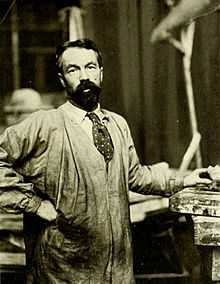 Karl Bitter in 1907. | |
| Born |
Karl Theodore Francis Bitter December 6, 1867 Vienna |
| Died | April 9, 1915 (aged 47) |
| Alma mater | Academy of Fine Arts Vienna |
| Spouse(s) | Marie A. Sherrill |
Karl Theodore Francis Bitter (December 6, 1867 – April 9, 1915) was an Austrian-born American sculptor best known for his architectural sculpture, memorials and residential work.
Life and career
The son of Carl and Henrietta (Reitter) Bitter,[1] he was born and trained in Vienna. His early training took place at the Kunstgewerbeschule (the imperial school for the applied arts), and after that at the Kunstakademie (the Academy of Fine Arts). At the Academy, he studied with August Kühne and Edmund Heller.[2] Upon his graduation, he was apprenticed to an architectural sculptor, Kaffsack. This was the period that the Ringstraße was being built in Vienna, and a large number of decorated buildings were being built.
In 1889, while on leave from the army, he immigrated to the United States out of protest regarding military service during peacetime. He was unable to return to Austria for many years because of his desertion. He later was pardoned by Emperor Franz Josef of Austria, who hoped to lure the (by then) famous sculptor back to Vienna.[3]
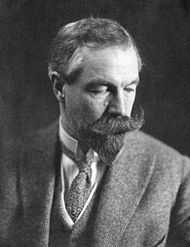
Upon arriving in New York City, Bitter applied for citizenship, and set to work as an assistant with a firm of house decorators. While employed with this firm, he competed for the Astor memorial bronze gates of Trinity Church and won, being but 21 years of age at the time. The work gave him sufficient capital to build and establish a small studio on Thirteenth Street.[1]
About this time, Bitter was discovered by Richard Morris Hunt, the architect of choice of many of New York’s rich and famous. From that time on Bitter was never without work. After working as a sculptor at the World's Columbian Exposition in Chicago in 1893 and as director at the Pan-American Exposition in Buffalo, New York in 1901, Bitter’s extraordinary organizational skills led him to be named head of the sculpture programs at both the 1904 St. Louis Exposition in St. Louis, Missouri, where Lee Lawrie trained with his guidance, and the 1915 Panama-Pacific Exposition held in San Francisco, California. In 1906/1907, he presided over the National Sculpture Society.
Among the awards won by Bitter were the silver medal of the Paris Exposition, 1900; the gold medal of the Pan-American Exposition, 1901; a gold medal at Philadelphia, 1902; and the gold medal at the St. Louis Exposition, 1904. He was a member of the National Institute of Arts and Sciences, vice-president (1906-08 and 1914-15); the National Academy of Design, to which he was elected in 1902; the American Academy of Arts and Letters, Players' Club, Century Club, and vice-president of the Architectural League in 1904-06 and 1909-11, and member of the Art Commission, New York, from 1912-15.[1][2]

Although Bitter arose out of the Classical/Naturalist styles he was increasingly turning towards a more modern approach to sculpture. Much of the work in Buffalo and St. Louis was allegorical in nature. Where this would have taken him will never be known, because he was killed in a tragic accident in 1915 when, while leaving the Metropolitan Opera in New York, a car jumped the curb and struck him down. His wife survived the accident as he had pushed her out of the way of the oncoming car.[1]
Like many of the sculptors and painters of the day, Bitter frequently employed the services of the muse and history’s first "super model", Audrey Munson. On 30 June 1901, he married Marie A. Sherrill, of Cincinnati, Ohio. They had three children: Francis T. R. Bitter, Mariette C. E. Bitter and John F. Bitter.[1] Their son Francis Bitter, born in 1902, became a prominent American physicist.
For a time, Bitter's studio was located in a building, known as The Castle in Weehawken, New Jersey. The Castle was created as a part of the Eldorado Amusement Park.[4]
Architectural sculpture

- East Doors & Tympanum, Trinity Church, New York, 1891
- Elements Controlled and Uncontrolled – Administration Building at the Chicago World's Fair, 1893
- Broad Street Station, Pennsylvania Railroad – Frank Furness architect, Philadelphia, Pennsylvania:
- Spirit of Transportation, 1894; now located in 30th Street Station.[5]
- Pediment over 15th Street, 1894, destroyed.
- Horace Jayne House – Frank Furness architect, 19th & Delancey Streets, Philadelphia, Pennsylvania, 1895
- Biltmore Estate – Richard Morris Hunt architect, Asheville, North Carolina, 1895
- St Paul Building – George B. Post architect, NYC, 1896
- Decorations on the Dewey Arch – New York, 1899
- Metropolitan Museum of Art – Richard Morris Hunt architect, NYC, 1901; Bitter's models of the Arts were never executed in stone, but the uncarved blocks remain on the Fifth Avenue facade.
- United States Customs House – Cass Gilbert architect, NYC 1906
- Cleveland Trust Company – George B. Post architect, Cleveland Ohio, 1907
- First National Bank – Milton J. Dyer architect, Cleveland Ohio, 1908
- Cuyahoga County Courthouse – Cleveland Ohio, 1908, 1914
- Wisconsin State Capitol – George Post architect, Madison Wisconsin 1908, 1910, 1912
Monuments and other works

- Dr. William Pepper, College Hall, University of Pennsylvania, 1896.[6] A replica of this is at the Free Library of Philadelphia, Philadelphia, Pennsylvania.
- Louisiana Purchase Group – St. Louis Missouri, 1904
- Thomas Jefferson Missouri History Museum, St. Louis Missouri, 1913[7]
- Louisiana Purchase Bronze, Missouri History Museum, St. Louis Missouri, 1913
- General Franz Sigel – NYC, 1907
- Dr. James Burrill Angell Memorial – University of Michigan, Ann Arbor, Michigan, 1909
- Henry Tappen Memorial – University of Michigan, Ann Arbor, Michigan, 1912
- Carl Schurz Monument – Morningside Park, New York City, 1913
- Thomas Jefferson – University of Virginia, Charlottesville, Virginia, 1915
- Thomas Lowry Monument – Minneapolis, Minnesota, 1915
- Pomona for Pulitzer Fountain, NYC (completed by Isidore Konti and Karl Gruppe), 1915
- Andrew Dickson White – Cornell University, Ithaca, New York 1915
- Depew Memorial Fountain – Indiana World War Memorial Plaza, completed by Alexander Stirling Calder, Indianapolis 1915
Selected funerary or cemetery works
- John Erastrus Hubbard Memorial – Montpelier, Vermont, 1903 (John Erastrus Hubbard at Find a Grave)
- Henry Villard Memorial – Sleepy Hollow, New York, 1904
- Prehn Memorial – Passaic, New Jersey, 1911
- Louise Dellmayer Kasson Memorial[8] – Utica, New York, 1915
Gallery
-
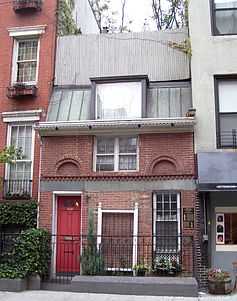
The studio in Manhattan that Bitter shared with Giuseppe Moretti.
-

Bronze bust of architect Richard Morris Hunt (1891), National Portrait Gallery, Washington D.C.
-

Pediment over 15th Street, Broad Street Station, Philadelphia, Pennsylvania (1894, destroyed).
-
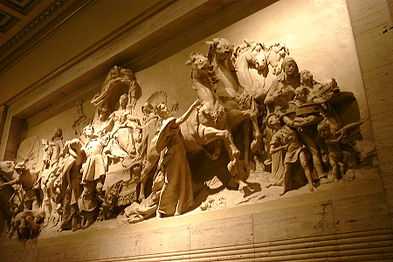
The Spirit of Transportation, 30th Street Station, Philadelphia, PA (1894).
-
Horace Jayne House, Philadelphia, Pennsylvania (1895), Frank Furness, architect.
-
Dr. William Pepper (1899), Free Library of Philadelphia.
-

Triumphal Bridge, Pan-American Exposition, Buffalo, NY (1901), John M. Carrere, architect.
-
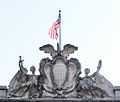
Symbols of Government (1907) Alexander Hamilton U.S. Custom House, New York
-

Wisconsin State Capitol, Madison, Wisconsin (1908–12), George B. Post, architect.
-

Alexander Hamilton (1914), Cuyahoga County Courthouse, Cleveland Ohio.
-

Thomas Lowry Memorial statue, Minneapolis, Minnesota (1915).
-

Andrew Dickson White statue, Cornell University, Ithaca, New York (1915).
-

Thomas Jefferson (1915), University of Virginia, Charlottesville, Virginia.
-

Carl Schurz Monument in Morningside Park, Manhattan, New York City (1913).
References
- ↑ 1.0 1.1 1.2 1.3 1.4
 Homans, James E., ed. (1918). "Bitter, Karl Theodore Francis". The Cyclopædia of American Biography. New York: The Press Association Compilers, Inc.
Homans, James E., ed. (1918). "Bitter, Karl Theodore Francis". The Cyclopædia of American Biography. New York: The Press Association Compilers, Inc. - ↑ 2.0 2.1
 Rines, George Edwin, ed. (1920). "Bitter, Karl Theodore Francis". Encyclopedia Americana.
Rines, George Edwin, ed. (1920). "Bitter, Karl Theodore Francis". Encyclopedia Americana. - ↑ 3.0 3.1 "Karl Bitter's Statuary on St. Paul Building May Be Offered Austria, Which Exiled Him", The New York Times. December 2, 1957. Page 24. Retrieved March 15, 2011.
- ↑ "Karl Bitter Studio at The Castle". Weehawken Time Machine.
- ↑ http://www.lindamann.com/otherpainters/bitter/default.htm
- ↑ http://www.philart.net/art.php?id=435
- ↑ http://www.forestparkstatues.org/#/thomas-jefferson/
- ↑ "Art Inventories Catalog: Kasson Memorial, (sculpture).". si.edu. Retrieved 1 December 2011.
Further reading
| Wikimedia Commons has media related to Karl Bitter. |
| Wikisource has the text of the 1911 Encyclopædia Britannica article Bitter, Karl Theodore Francis. |
| Wikisource has the text of the 1921 Collier's Encyclopedia article Bitter, Karl Theodore Francis. |
- Bitter's own description of his Sculpture Plan for the 1901 Buffalo world's fair
- Dennis, James M., Karl Bitter: Architectural Sculptor 1867 - 1915, University of Wisconsin Press 1967
- Kvaran, Einar Einarsson, Architectural Sculpture of America, unpublished manuscript
- Schevill, Ferdinand (1917). Karl Bitter: A Biography. Chicago, Illinois: University of Chicago Press.
|

